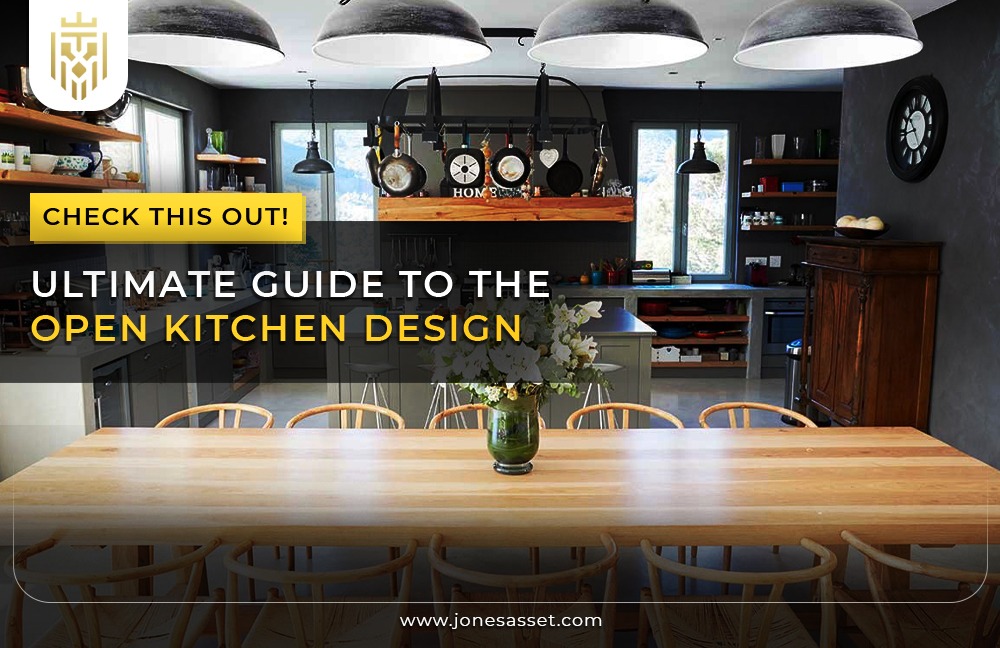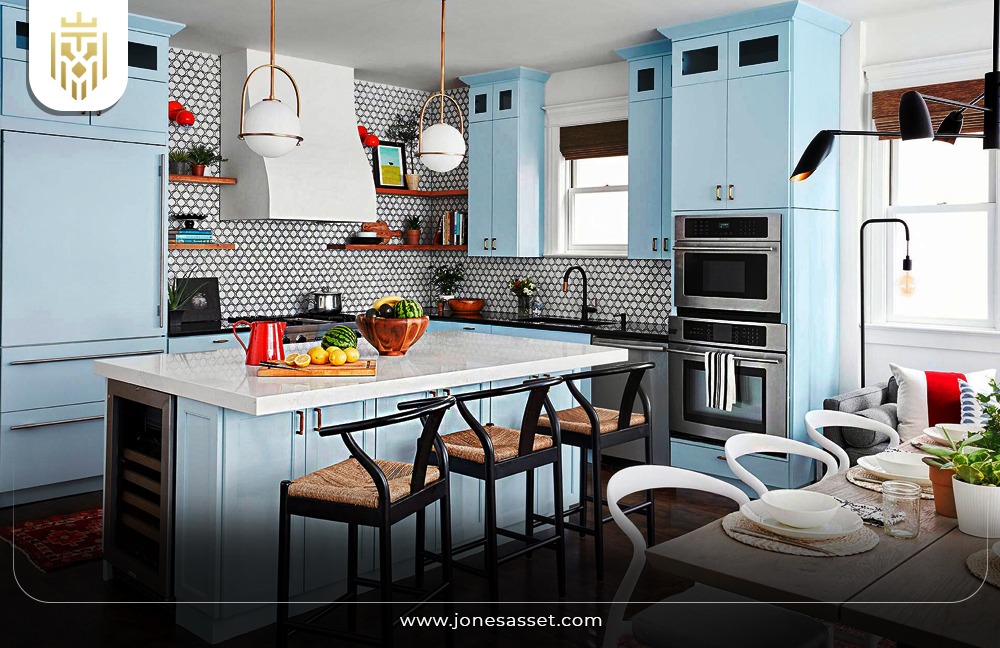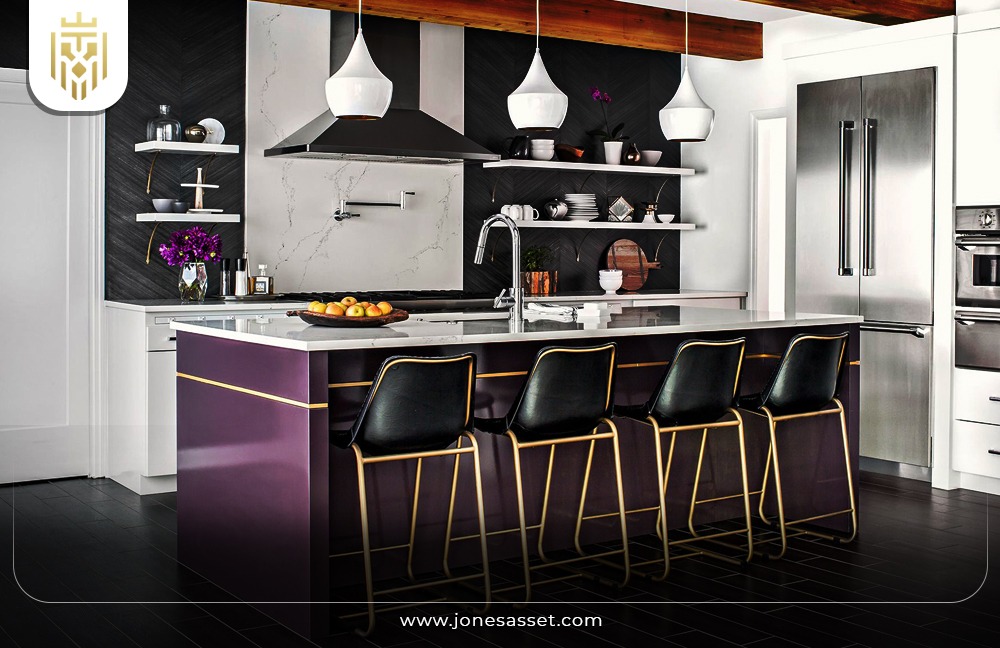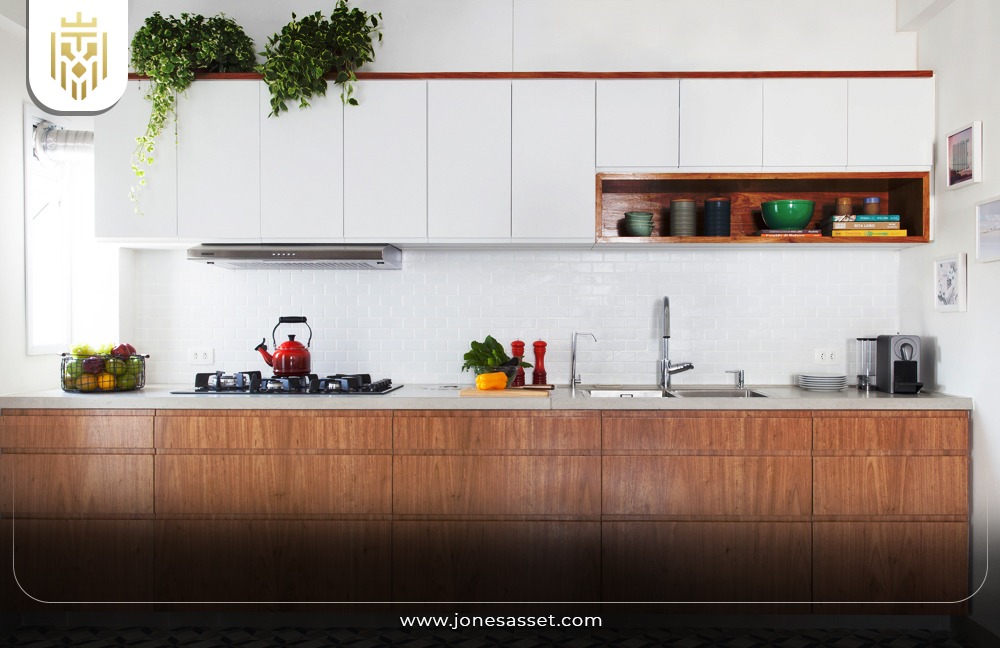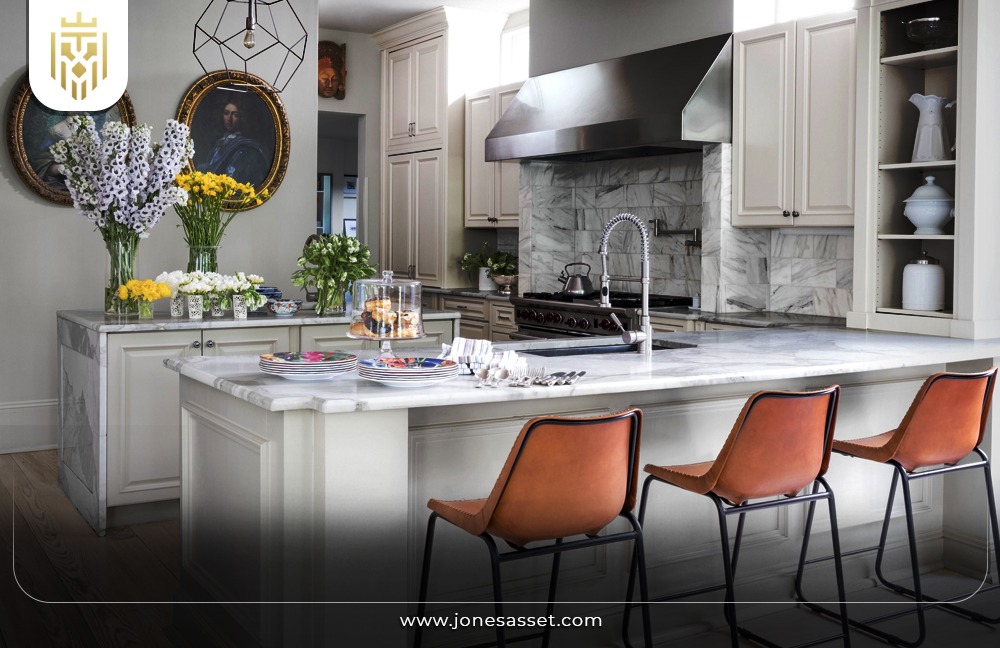Open Kitchen Design:
An open kitchen layout means that the kitchen is not separated from the rest of the living spaces, and the area is large and seamless. It underlines the flexibility of spaces, and the incorporation of natural light and links between various elements and levels thus improving the looks as well as usability of a space. Well suited for socializing, entertaining, and interacting with family members, combining the cooking and living areas.
What is the Open Kitchen Concept:
The open kitchen concept entails the elimination of partitions that separate the kitchen from other living spaces, like the dining room or the living room. These factors enhance the flow of space in an interconnected manner hence enhancing interaction and visibility. In the context of the author’s discussion, it creates a more polite environment where cooking and other interpersonal engagements occur at the same time.
Benefits of Open Kitchen Concept:
The open kitchen has the advantages of increased natural lighting, ample fresh air circulation, and also social interaction. These changes make the space appear larger and more friendly, enhance the chances of communication, and also enable one to attend to two activities at the same time. Also, the incorporation of open kitchens can go a long way in increasing the home’s value and marketing it to the modern and wellness-conscious buyer.
How to design your Open Kitchen Design:
The design of an open kitchen plan needs to be well-planned. Increased concentration must be placed on the continuity of the color scheme of the rooms and the utilization of the material used in adjacent units. Check for adequate lighting and proper ventilation of the facilities. Install an eating and working multifunctional island. We shall go through some of these design ideas:
Open your Kitchen To the Outside:
There are several ways through which one can open one’s kitchen to the outside and some of them include the following; use of big windows, extended sliding doors, and a moving wall. Besides improving the diffusion of natural light and air, it helps define an effective connection between internal and external spaces. It is wholesome for watching and having fun with nature from the comfort of your home.
Add Texture:
Different principles such as the use of wood, stone, or tiles can be used to reduce openness in an open kitchen. Concepts of subway tile textures with contrasting backsplash textures, wood beams, or a stone counter add much-needed appeal. The use of different textured materials in the dining area nurtures rhythm and expectancy toward aesthetics apart from the comfort of stylish furniture pieces.
Eliminate Walls of Cabinet:
Open storage and removal of upper cabinets in an open kitchen allow the space to be more open, and airy. This will however not hinder one from keeping their things in storage where instead they can go for things like open shelving lower cabinets, or even a pantry. This system improves organization, increases space utilization, and is just generally less ‘cluttered’ or ‘old’ looking.
Add an Extra Large Island:
An extra-large island in an open kitchen serves multiple functions: extra workspace, storage space, and sitting arrangement. This makes it a central location for preparing food, eating, and also social interaction with family members or other people. Make sure it fits in with the other furniture and appliances and has necessary utility such as a sink or cooktop.
Go All White or Full Beige Palette:
Out of all the possibilities, selecting an all-white or full beige for the open kitchen is suitable because it is bright and minimalist. These colors do not dominate or emphasize certain parts of the room and make it look larger and well-connected. Bring interest with the fun of different textures and materials at every point; so the space will not become dull or repetitious.
Keep Clutter To a minimum:
This is because it would be possible to have other living areas within the house directly vicinally related to the kitchen hence some levels of clutter may occur. Use pull-out shelves, integrated shelves, and pantry drawers and shelves. Finally, always remove a lot of things from countertops, as well as maintain only the most necessary things; their presence disrupts the openness of the space.
Create Extra Seating:
There are ways to establish additional seating within an open-concept kitchen; they include a breakfast bar, a large island, and a built-in bench. This makes the kitchen more than a place for preparing food but a social place for the family, a dining hall, or just a room for doing homework, among others.
Dark Elements add Contrast:
Integrating items such as cabinetry, countertops, or fixtures with dark colors will give the open kitchen a mystic look and feel. This can give the space somewhat of a more refined look and feel with the added sense of a more harmonious flow. It is also true that dark accents draw more attention to these areas and can have a highly dramatic effect on the overall image, especially when placed on a lighter background.
Best Open Kitchen for Indian Homes:
Designing is extremely important especially when it comes to Indian homes where an open kitchen should be both functional and beautiful. Ventilation should be optimized and along with it, one should try also to incorporate parts of traditional Indian kitchens such as tandoor or spice shelf. Choose items that are strong and resistant to the pressure of constant use in the kitchen.
An Open Kitchen with a Rustic Charm:
An open or rustic Indian kitchen has contrasts of wooden cabinets with stone tops and colors of earth. Introduce conventional Indian aesthetics such as brass accents and hand-made encaustic tiles. This style gives character and a homely feeling where people would be more than willing to spend time in the kitchen.
Dining Room inside an open Kitchen:
The location of the dining area in an open kitchen is always efficient in space utilization and sociability of the family. Choose a multipurpose dining table that be used for prepping food too. Make sure that there is enough lighting and ensure that the area of the house dealing with cooking is well connected to the area where people will be eating.
One Wall is Enough for Kitchen:
A one-wall kitchen is very effective in constrained living spaces as in compact houses. It organizes all appliances, countertops, and the island, and the cabinets are aligned on a wall, which is effective. This position provides the required space for flexibility to have the cooking space blend with the living or dining area in what is referred to as an open floor design.
Open Kitchen Packed with Storage:
A large kitchen with much storage space solves this problem by applying pull-out cupboards, tall cupboards on the ceiling, and a built-in pantry. Utilize more of the vertical area and try to use multipurpose items as much as possible. This helps to avoid the accumulation of items retains the openness of the house and at the same time facilitates the storage of all kitchen utensils and equipment needed.
Opening into Outdoors:
An open kitchen that has been designed to open up to the outside is efficient regarding air circulation and downlight. There are picture, sliding glass doors or bi-fold windows where the exterior and interior of the facility almost blend. This configuration is great for hosting or just having fun and being outside while grilling or dining.
A Window to Living Room:
The incorporation of a window between the kitchen and the remaining kitchen makes the two areas more connected and visible. It enables the admission of natural light and it does not create closeness, that is enclosure. This aspect enables one space to interconnect with another and that brings a feeling of togetherness in the home.
Modern Open Kitchen design ideas:
Open kitchen designs of the present era are mostly associated with simplicity, efficiency, and look. Some of the elements of kitchens include smooth-surfaced cabinets, quality appliances, and well-selected colors. Create built-in multifunctional islands, clocks, and other smart storage places, as well as the most stylish lighting devices. The utilization of open shelves, combined dining areas, and new materials such as quartz and stainless steel significantly boost the modern aspect.
L-Shaped Open Kitchen Design:
An L-shaped open kitchen adjoins two walls, which makes it convenient to put the cooktop and oven side by side as well as the sink and refrigerator. It is specifically suitable when one has limited space, especially in the corners and it is easy to incorporate with living or dining areas. They also offer enough countertop space and numerous possibilities concerning the setting of appliances.
Peninsula Open Kitchen Design:
The peninsula kitchen has an off-shoot, an island that is joined to the primary counter with extra working and dining space. It divides the kitchen from other spaces without completely enclosing it, thus, improving the Connection between the two. Such a design is ideal for houses with limited space since it adds multiple uses to a single room.
U-Shaped Kitchen Design:
A U-sided kitchen has three sides covered with cabinets and appliances providing the cook with the best kitchen layout for his or her job. This type of layout works well for an extended area where more counter area is possible and a particular cooking area can be established. It provides direct access to all the kitchen sections/areas; thus, improving the traffic flow.
Integrated Open Kitchen Design:
The open kitchen is continuous with the living or dining area and it is implemented using the same finishes and details. Some spaces are equipped with various appliances, integrated cabinets, and other pieces of furniture that do not attract attention by their design and blend in with the overall design concept. This design helps increase the level of connectivity and results in an integrated and contemporary area of residence.
Disadvantages of Open-Kitchen Design:
There are some issues to be addressed to understand that open kitchen designs have some negative effects like noises and smells of the food that the cook gets through living spaces. They tend to call for planning to ensure that they do not become messy. Furthermore, since there are no walls on three sides in most cases, storage space might be confined, and privacy while preparing the meals may be an issue.
Wrapping Up!
Modern open kitchen designs entail the integration of style and well-being with aesthetics thus improving the daily living experience. Despite the issues associated with slopes, new interaction, natural lighting, and enhancement of the structures’ looks tend to overcome the issues. This means that it is possible to order an open kitchen that meets your needs, should you make thorough preparations and choose intelligent designs.
FAQs
1. What is an open kitchen concept?
An open kitchen means a kitchen without partitions from adjacent living spaces to make one whole area. This design increases communication and exposure.
2. How to design your open kitchen?
For designing an open direct kitchen, make sure that the targeted color patterns are in harmony, incorporate multipurpose storage islands, and opt for proper lighting. Always provide sufficient storage with smart space ideas and do not let the space become messy.
3. What are the benefits of an open kitchen?
Open kitchen layouts increase social contact, boost the lighting, and air, and create an illusion of more space.
4. Modern open kitchen design ideas?
Today’s open kitchens are more refined with smooth fitting and finish, high-quality appliances, and integrated dining space. So the best products to use for kitchen design are multifunctional islands, open shelves, and innovative materials such as quartz and stainless steel.

